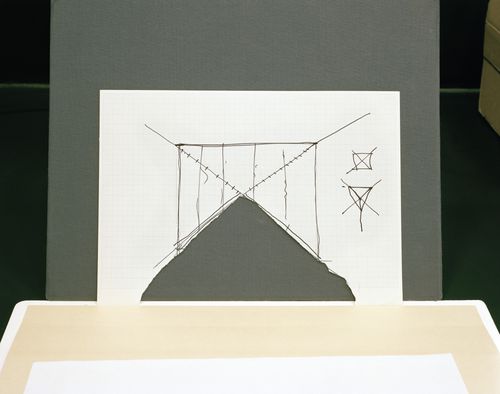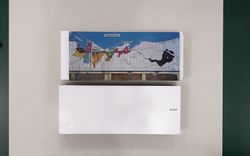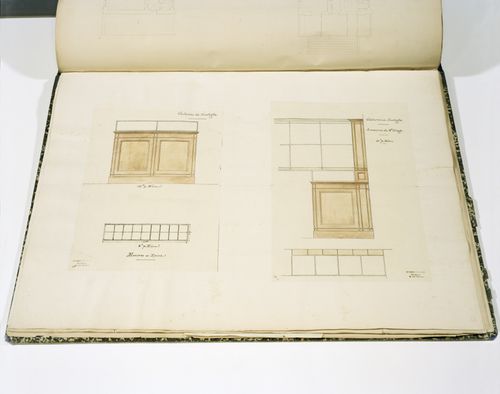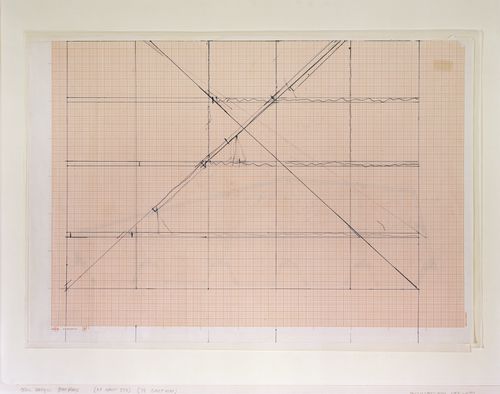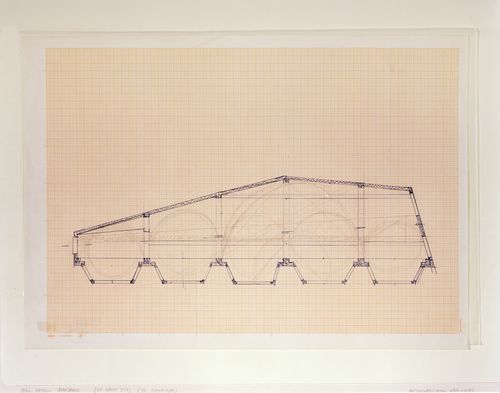Sous-série
AP178.S1.1988.PR07.SS11
Description:
This project series documents the Estaçäo de Metropolitano Baixa Chiado in Lisbon, Portugal. The office assigned the dates 1992-1998 for this project. The Estaçäo de Metropolitano Baixa Chiado was built between 1992 and 1998. The station played a key role in Siza's functional reconstruction plan of the Chiado area. It was an essential part of Siza's recovery plan for the district of Chiado in order to create more access to different parts of town due to the irregular elevations of the district. The station's escalators were created to give access to the Rua do Crucifixo and Largo do Chiado square. Elevators were also built to give access to Rua Ivens. Drawings include sketches, studies, working drawings, shop drawings and mechanical drawings. Textual documentation includes specifications, correspondence, permit and supplier documentation, and meeting reports. Photographic materials document the model, site and construction work. The materials that were donated in the 2019 accession document the elevators built to give access to Rua Ivens. Additional documentation for this project can also be found in the project subseries AP178.S1.1988.PR07.SS1.
1987-2012
Estação de Metropolitano Baixa Chiado [Baixa Chiado Metropolitan Station], Lisbon, Portugal (1988-1998)
Actions:
AP178.S1.1988.PR07.SS11
Description:
This project series documents the Estaçäo de Metropolitano Baixa Chiado in Lisbon, Portugal. The office assigned the dates 1992-1998 for this project. The Estaçäo de Metropolitano Baixa Chiado was built between 1992 and 1998. The station played a key role in Siza's functional reconstruction plan of the Chiado area. It was an essential part of Siza's recovery plan for the district of Chiado in order to create more access to different parts of town due to the irregular elevations of the district. The station's escalators were created to give access to the Rua do Crucifixo and Largo do Chiado square. Elevators were also built to give access to Rua Ivens. Drawings include sketches, studies, working drawings, shop drawings and mechanical drawings. Textual documentation includes specifications, correspondence, permit and supplier documentation, and meeting reports. Photographic materials document the model, site and construction work. The materials that were donated in the 2019 accession document the elevators built to give access to Rua Ivens. Additional documentation for this project can also be found in the project subseries AP178.S1.1988.PR07.SS1.
Project
1987-2012
Projet
AP056.S1.1989.PR08
Description:
This project series documents the winning competition entry and subsequent construction for Kitchener City Hall in Kitchener, Ontario from 1989-1993. The office identified the project number as 8928. This project consisted of a U-shaped civic building comprised of a circular rotunda in the centre, an office tower to the right, the council chambers to the left, and two rectangular arms on either side to create the arms of the U. These elements, which wrapped around a large reflecting pool that doubled as a skating rink, were visually separated but coherent in their design and use of materials. Located on the block between Young, College, Duke and King Streets, the interior and exteriors of the property were designed for city government, but also for the larger public with community, public spaces, and open interaction with local government as key design concepts for the project. After entering the Civic Square outside the building, patrons can pass through the main portico, into the Interior Civic Square were the round Civic Rotunda rests in the centre. The rotunda’s interior was designed for use as a public gathering space, where events and activities could be held. The top of the rotunda had sandblasted glass windows with patinated copper frames, letting natural light shine into the large space below. A staircase from the main Civic Square led to an exterior terrace that wrapped around the top of the rotunda. The Administrative Office Tower was ten-storeys with a mechanical penthouse, and was used for civic offices. The Council Chamber was comprised of limestone with refinished metal panels forming a curved roof on top. The two wings along the sides of the property contained tenant areas, a restaurant, information offices, alderman’s offices and the mayor’s office, among other spaces. The back of the property had landscaped exteriors and outdoor play areas for the building’s daycare. The project is recorded through drawings, photographic materials, presentation paintings and models dating from 1989-1993. The drawings consist of concepts for both the competition entry and the subsequent construction of the project. These include sketches, base maps and area surveys produced by the city and contractors, presentation boards and paintings, plans, elevations, sections, perspectives, details and axonometric drawings. There are also photographic reproductions of presentation drawings. The photographs show finished interiors and exteriors and the project model.
1989-1993
Kitchener City Hall Competition, Ontario (1989-1993)
Actions:
AP056.S1.1989.PR08
Description:
This project series documents the winning competition entry and subsequent construction for Kitchener City Hall in Kitchener, Ontario from 1989-1993. The office identified the project number as 8928. This project consisted of a U-shaped civic building comprised of a circular rotunda in the centre, an office tower to the right, the council chambers to the left, and two rectangular arms on either side to create the arms of the U. These elements, which wrapped around a large reflecting pool that doubled as a skating rink, were visually separated but coherent in their design and use of materials. Located on the block between Young, College, Duke and King Streets, the interior and exteriors of the property were designed for city government, but also for the larger public with community, public spaces, and open interaction with local government as key design concepts for the project. After entering the Civic Square outside the building, patrons can pass through the main portico, into the Interior Civic Square were the round Civic Rotunda rests in the centre. The rotunda’s interior was designed for use as a public gathering space, where events and activities could be held. The top of the rotunda had sandblasted glass windows with patinated copper frames, letting natural light shine into the large space below. A staircase from the main Civic Square led to an exterior terrace that wrapped around the top of the rotunda. The Administrative Office Tower was ten-storeys with a mechanical penthouse, and was used for civic offices. The Council Chamber was comprised of limestone with refinished metal panels forming a curved roof on top. The two wings along the sides of the property contained tenant areas, a restaurant, information offices, alderman’s offices and the mayor’s office, among other spaces. The back of the property had landscaped exteriors and outdoor play areas for the building’s daycare. The project is recorded through drawings, photographic materials, presentation paintings and models dating from 1989-1993. The drawings consist of concepts for both the competition entry and the subsequent construction of the project. These include sketches, base maps and area surveys produced by the city and contractors, presentation boards and paintings, plans, elevations, sections, perspectives, details and axonometric drawings. There are also photographic reproductions of presentation drawings. The photographs show finished interiors and exteriors and the project model.
Project
1989-1993
PH2018:0005:011
Description:
Photograph by Stefano Graziani of the following work: Gordon Matta-Clark, drawing n.6 from seven proposals for Documenta, 1977, 21.0 x 30.2cm, PHCON2002:0016:046:006, Gordon Matta-Clark Collection, Canadian Centre for Architecture, Gift of Estate of Gordon Matta-Clark, © Estate of Gordon Matta-Clark Questioning Pictures is a 36 photograph project commissioned by Fondazione Prada, Milan. Artist Stefano Graziani investigates archival and conservation systems in a number of museums. Through photographing museum objects, Graziani, focusing on the relationship between photographs, the museum objects and the power structures at play within institutions. The museums include the Canadian Centre for Architecture (CCA) in Montréal, Canada; Sir John Soane’s Museum in London, UK; the Kunstmuseum Basel, Switzerland; Museum Insel Hombroich in Neuss, Germany; the Museo di Castelvecchio in Verona, Italy; and the Plaster Cast Gallery at Museo Canova in Possagno, Italy.
2017
Questioning Pictures: Photograph of drawing no.6 from seven proposals for Documenta by Gordon Matta-Clark, 1977
Actions:
PH2018:0005:011
Description:
Photograph by Stefano Graziani of the following work: Gordon Matta-Clark, drawing n.6 from seven proposals for Documenta, 1977, 21.0 x 30.2cm, PHCON2002:0016:046:006, Gordon Matta-Clark Collection, Canadian Centre for Architecture, Gift of Estate of Gordon Matta-Clark, © Estate of Gordon Matta-Clark Questioning Pictures is a 36 photograph project commissioned by Fondazione Prada, Milan. Artist Stefano Graziani investigates archival and conservation systems in a number of museums. Through photographing museum objects, Graziani, focusing on the relationship between photographs, the museum objects and the power structures at play within institutions. The museums include the Canadian Centre for Architecture (CCA) in Montréal, Canada; Sir John Soane’s Museum in London, UK; the Kunstmuseum Basel, Switzerland; Museum Insel Hombroich in Neuss, Germany; the Museo di Castelvecchio in Verona, Italy; and the Plaster Cast Gallery at Museo Canova in Possagno, Italy.
PH2018:0005:012
Description:
Photograph by Stefano Graziani of the following work: James Stirling, Michael Wilford and Associates, study model for the east elevation, Clore Gallery, London, 1978-1986, 12.0 x 30.3 x 8.2 cm, AP140.S2.SS1.D60.SD1.P127, James Stirling / Michael Wilford Fonds, Canadian Centre for Architecture, Montréal Questioning Pictures is a 36 photograph project commissioned by Fondazione Prada, Milan. Artist Stefano Graziani investigates archival and conservation systems in a number of museums. Through photographing museum objects, Graziani, focusing on the relationship between photographs, the museum objects and the power structures at play within institutions. The museums include the Canadian Centre for Architecture (CCA) in Montréal, Canada; Sir John Soane’s Museum in London, UK; the Kunstmuseum Basel, Switzerland; Museum Insel Hombroich in Neuss, Germany; the Museo di Castelvecchio in Verona, Italy; and the Plaster Cast Gallery at Museo Canova in Possagno, Italy.
2017
Questioning Pictures: Photograph of study model for the east elevation by James Stirling, Michael Wilford and Associates, 1978-1986
Actions:
PH2018:0005:012
Description:
Photograph by Stefano Graziani of the following work: James Stirling, Michael Wilford and Associates, study model for the east elevation, Clore Gallery, London, 1978-1986, 12.0 x 30.3 x 8.2 cm, AP140.S2.SS1.D60.SD1.P127, James Stirling / Michael Wilford Fonds, Canadian Centre for Architecture, Montréal Questioning Pictures is a 36 photograph project commissioned by Fondazione Prada, Milan. Artist Stefano Graziani investigates archival and conservation systems in a number of museums. Through photographing museum objects, Graziani, focusing on the relationship between photographs, the museum objects and the power structures at play within institutions. The museums include the Canadian Centre for Architecture (CCA) in Montréal, Canada; Sir John Soane’s Museum in London, UK; the Kunstmuseum Basel, Switzerland; Museum Insel Hombroich in Neuss, Germany; the Museo di Castelvecchio in Verona, Italy; and the Plaster Cast Gallery at Museo Canova in Possagno, Italy.
articles
Cartes postales en mouvement
30 octobre 2023
Cartes postales en mouvement
Armin Linke sur les infrastructures mondiales, l'anthropocène et le jeu avec le public
Actions:
PH2018:0005:024
Description:
Photograph by Stefano Graziani of the following work: Charles Rohault de Fleury, design development drawings for a «Galerie de zoologie», Museum national d'historie naturelle, Paris, mid 19th century, from Album Museum national d'historie naturelle, Charles de Rohault de Fleury collection, DR1974:0002:024:001-079, Canadian Centre for Architecture, Montréal Questioning Pictures is a 36 photograph project commissioned by Fondazione Prada, Milan. Artist Stefano Graziani investigates archival and conservation systems in a number of museums. Through photographing museum objects, Graziani, focusing on the relationship between photographs, the museum objects and the power structures at play within institutions. The museums include the Canadian Centre for Architecture (CCA) in Montréal, Canada; Sir John Soane’s Museum in London, UK; the Kunstmuseum Basel, Switzerland; Museum Insel Hombroich in Neuss, Germany; the Museo di Castelvecchio in Verona, Italy; and the Plaster Cast Gallery at Museo Canova in Possagno, Italy.
2017
Questioning Pictures: Photograph of design development drawings for a «Galerie de zoologie» by Charles Rohault de Fleury, mid 19th century
Actions:
PH2018:0005:024
Description:
Photograph by Stefano Graziani of the following work: Charles Rohault de Fleury, design development drawings for a «Galerie de zoologie», Museum national d'historie naturelle, Paris, mid 19th century, from Album Museum national d'historie naturelle, Charles de Rohault de Fleury collection, DR1974:0002:024:001-079, Canadian Centre for Architecture, Montréal Questioning Pictures is a 36 photograph project commissioned by Fondazione Prada, Milan. Artist Stefano Graziani investigates archival and conservation systems in a number of museums. Through photographing museum objects, Graziani, focusing on the relationship between photographs, the museum objects and the power structures at play within institutions. The museums include the Canadian Centre for Architecture (CCA) in Montréal, Canada; Sir John Soane’s Museum in London, UK; the Kunstmuseum Basel, Switzerland; Museum Insel Hombroich in Neuss, Germany; the Museo di Castelvecchio in Verona, Italy; and the Plaster Cast Gallery at Museo Canova in Possagno, Italy.
PH2018:0005:003
Description:
Photograph by Stefano Graziani of the following work: James Stirling, diagram of interior environment controls for the History Faculty Building, University of Cambridge, between 1963 -1967, ink on paper, 25.8 x 33.8 cm, AP140.S2.SS1.D26.P2.2, James Stirling / Michael Wilford fonds, Canadian Centre for Architecture, © CCA, Montréal Questioning Pictures is a 36 photograph project commissioned by Fondazione Prada, Milan. Artist Stefano Graziani investigates archival and conservation systems in a number of museums. Through photographing museum objects, Graziani, focusing on the relationship between photographs, the museum objects and the power structures at play within institutions. The museums include the Canadian Centre for Architecture (CCA) in Montréal, Canada; Sir John Soane’s Museum in London, UK; the Kunstmuseum Basel, Switzerland; Museum Insel Hombroich in Neuss, Germany; the Museo di Castelvecchio in Verona, Italy; and the Plaster Cast Gallery at Museo Canova in Possagno, Italy.
2017
Questioning Pictures: Photograph of diagram of interior environment controls for the History Faculty Building by James Stirling, 1963-1967
Actions:
PH2018:0005:003
Description:
Photograph by Stefano Graziani of the following work: James Stirling, diagram of interior environment controls for the History Faculty Building, University of Cambridge, between 1963 -1967, ink on paper, 25.8 x 33.8 cm, AP140.S2.SS1.D26.P2.2, James Stirling / Michael Wilford fonds, Canadian Centre for Architecture, © CCA, Montréal Questioning Pictures is a 36 photograph project commissioned by Fondazione Prada, Milan. Artist Stefano Graziani investigates archival and conservation systems in a number of museums. Through photographing museum objects, Graziani, focusing on the relationship between photographs, the museum objects and the power structures at play within institutions. The museums include the Canadian Centre for Architecture (CCA) in Montréal, Canada; Sir John Soane’s Museum in London, UK; the Kunstmuseum Basel, Switzerland; Museum Insel Hombroich in Neuss, Germany; the Museo di Castelvecchio in Verona, Italy; and the Plaster Cast Gallery at Museo Canova in Possagno, Italy.
PH2018:0005:031
Description:
Photograph by Stefano Graziani of the following work: Gordon Matta-Clark, floor plan for Office Baroque, 1977, blue ballpoint pen on graph paper, 42 x 59.5 cm, PHCON2002:0016:059, Gordon Matta-Clark collection, Canadian Centre of Architecture, Gift of Estate of Gordon Matta-Clark, © Estate of Gordon Matta-Clark Questioning Pictures is a 36 photograph project commissioned by Fondazione Prada, Milan. Artist Stefano Graziani investigates archival and conservation systems in a number of museums. Through photographing museum objects, Graziani, focusing on the relationship between photographs, the museum objects and the power structures at play within institutions. The museums include the Canadian Centre for Architecture (CCA) in Montréal, Canada; Sir John Soane’s Museum in London, UK; the Kunstmuseum Basel, Switzerland; Museum Insel Hombroich in Neuss, Germany; the Museo di Castelvecchio in Verona, Italy; and the Plaster Cast Gallery at Museo Canova in Possagno, Italy.
2017
Questioning Pictures: Photograph of floor plan for Office Baroque, blue pen on graph paper by Gordon Matta-Clark, 1977
Actions:
PH2018:0005:031
Description:
Photograph by Stefano Graziani of the following work: Gordon Matta-Clark, floor plan for Office Baroque, 1977, blue ballpoint pen on graph paper, 42 x 59.5 cm, PHCON2002:0016:059, Gordon Matta-Clark collection, Canadian Centre of Architecture, Gift of Estate of Gordon Matta-Clark, © Estate of Gordon Matta-Clark Questioning Pictures is a 36 photograph project commissioned by Fondazione Prada, Milan. Artist Stefano Graziani investigates archival and conservation systems in a number of museums. Through photographing museum objects, Graziani, focusing on the relationship between photographs, the museum objects and the power structures at play within institutions. The museums include the Canadian Centre for Architecture (CCA) in Montréal, Canada; Sir John Soane’s Museum in London, UK; the Kunstmuseum Basel, Switzerland; Museum Insel Hombroich in Neuss, Germany; the Museo di Castelvecchio in Verona, Italy; and the Plaster Cast Gallery at Museo Canova in Possagno, Italy.
PH2018:0005:033
Description:
Photograph by Stefano Graziani of the following work: Gordon Matta-Clark, floor plan for Office Baroque, 1977, blue ballpoint pen on graph paper, 42 x 59.5 cm, PHCON2002:0016:058, Gordon Matta-Clark collection, Canadian Centre of Architecture, Gift of Estate of Gordon Matta-Clark, © Estate of Gordon Matta-Clark Questioning Pictures is a 36 photograph project commissioned by Fondazione Prada, Milan. Artist Stefano Graziani investigates archival and conservation systems in a number of museums. Through photographing museum objects, Graziani, focusing on the relationship between photographs, the museum objects and the power structures at play within institutions. The museums include the Canadian Centre for Architecture (CCA) in Montréal, Canada; Sir John Soane’s Museum in London, UK; the Kunstmuseum Basel, Switzerland; Museum Insel Hombroich in Neuss, Germany; the Museo di Castelvecchio in Verona, Italy; and the Plaster Cast Gallery at Museo Canova in Possagno, Italy.
2017
Questioning Pictures: Photograph of floor plan for office Baroque, blue pen on graph paper by Gordon Matta-Clark, 1977
Actions:
PH2018:0005:033
Description:
Photograph by Stefano Graziani of the following work: Gordon Matta-Clark, floor plan for Office Baroque, 1977, blue ballpoint pen on graph paper, 42 x 59.5 cm, PHCON2002:0016:058, Gordon Matta-Clark collection, Canadian Centre of Architecture, Gift of Estate of Gordon Matta-Clark, © Estate of Gordon Matta-Clark Questioning Pictures is a 36 photograph project commissioned by Fondazione Prada, Milan. Artist Stefano Graziani investigates archival and conservation systems in a number of museums. Through photographing museum objects, Graziani, focusing on the relationship between photographs, the museum objects and the power structures at play within institutions. The museums include the Canadian Centre for Architecture (CCA) in Montréal, Canada; Sir John Soane’s Museum in London, UK; the Kunstmuseum Basel, Switzerland; Museum Insel Hombroich in Neuss, Germany; the Museo di Castelvecchio in Verona, Italy; and the Plaster Cast Gallery at Museo Canova in Possagno, Italy.
Projet
AP056.S1.1991.PR01
Description:
This project series documents a competition entry for the Vancouver Public Library in Vancouver from 1991-1992. The office identified the project number as 69112. The competition entry, submitted in 1991, consisted of the design of Vancouver's new public library, to be situated on the block between Homer, Georgia, Hamilton and Robson Streets. The project design included a seven-floor library connected by a walkway to an adjacent twenty-floor office tower that would house Public Works Canada. Both buildings had V shaped canopies on their roofs that looked like open books when viewed at an elevation. To the front of the library at ground level was the two-storey Library Concourse; a large hall made of glass windows and stone. The Concourse connected to the Robson Street entrance, and the Library Hall entrance at the corner of Homer and Georgia Streets. The architects described this as a porch-like space to be used for gatherings, public events, exhibits and displays. Moving into the heart of the library, patrons would pass through a cylindrical rotunda which extended upwards through every floor and above the roof terrace. The library would also have 2 levels of underground parking and a basement level with a circular theatre, concession areas and staff work areas. The ground floor would primarily consist of library stacks and tables but also included would be a gift shop, children's area, daycare, staff spaces, and an outdoor play area. The remaining floors were designated for library stacks, staff work areas and services. The top floor would hold administrative offices, built in a U shape around a large terrace. The terrace, complete with gardens, could be used for library events. This building would largely be made of glass windows at its exterior, with a round glass rotunda piercing through its rectangular shape. This project was never built. Although Kuwabara, Payne, McKenna, Blumberg Architects were finalists in this competition, the contract was eventually won and built by architect Moshe Safdie. The project is recorded through drawings, presentation panels, paintings, photographs and a model dating from 1991-1992. The drawings, which are mostly originals, include sketches, plans, sections, elevations, perspectives and isometrics. There are a number of watercolours (some mounted) and drawing panels used as presentation materials which have small texts about the project's design intention. The aquisition records for the 1993 donation of these project materials identify Michael McCann as the artist of 7 paintings in this project series; however it is not clear which 7 paintings were completed by this artist. The photographs show the completed project model, which is also contained in this project series.
1991-1992
Vancouver Public Library Competition, British Columbia (1991)
Actions:
AP056.S1.1991.PR01
Description:
This project series documents a competition entry for the Vancouver Public Library in Vancouver from 1991-1992. The office identified the project number as 69112. The competition entry, submitted in 1991, consisted of the design of Vancouver's new public library, to be situated on the block between Homer, Georgia, Hamilton and Robson Streets. The project design included a seven-floor library connected by a walkway to an adjacent twenty-floor office tower that would house Public Works Canada. Both buildings had V shaped canopies on their roofs that looked like open books when viewed at an elevation. To the front of the library at ground level was the two-storey Library Concourse; a large hall made of glass windows and stone. The Concourse connected to the Robson Street entrance, and the Library Hall entrance at the corner of Homer and Georgia Streets. The architects described this as a porch-like space to be used for gatherings, public events, exhibits and displays. Moving into the heart of the library, patrons would pass through a cylindrical rotunda which extended upwards through every floor and above the roof terrace. The library would also have 2 levels of underground parking and a basement level with a circular theatre, concession areas and staff work areas. The ground floor would primarily consist of library stacks and tables but also included would be a gift shop, children's area, daycare, staff spaces, and an outdoor play area. The remaining floors were designated for library stacks, staff work areas and services. The top floor would hold administrative offices, built in a U shape around a large terrace. The terrace, complete with gardens, could be used for library events. This building would largely be made of glass windows at its exterior, with a round glass rotunda piercing through its rectangular shape. This project was never built. Although Kuwabara, Payne, McKenna, Blumberg Architects were finalists in this competition, the contract was eventually won and built by architect Moshe Safdie. The project is recorded through drawings, presentation panels, paintings, photographs and a model dating from 1991-1992. The drawings, which are mostly originals, include sketches, plans, sections, elevations, perspectives and isometrics. There are a number of watercolours (some mounted) and drawing panels used as presentation materials which have small texts about the project's design intention. The aquisition records for the 1993 donation of these project materials identify Michael McCann as the artist of 7 paintings in this project series; however it is not clear which 7 paintings were completed by this artist. The photographs show the completed project model, which is also contained in this project series.
Project
1991-1992
